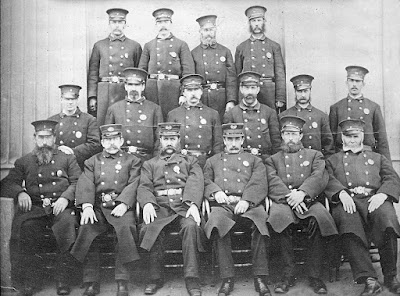We have a good idea who the other men, all patrolmen, are too (though we can’t match the names to the faces), thanks to a detailed report produced by Chief Bowman that year (and other years that he led the department). Additional research through local newspapers and other sources fills in more details about some of these men.
 |
| Chief Alonzo Bowman |
Bowman became chief of the department in 1876 and served in that capacity until his death in October 1899. (The photo of Bowman at left appeared on the front page of the Brookline Chronicle that month.)
Little is known about the other two officers who have been identified in the group photo. Harris Head, who was also born in Vermont, came to Brookline in the early 1870s. He apparently had only a brief career as a policeman and later ran a provisions store near the corner of Harvard and School Streets for many years. He died in 1906. Nothing more is known about Patrick H. Cusick.
Later pictures, in photographs and sketches, of three of the 1878 patrolmen are shown below as they appeared in the Brookline Chronicle. Can you match the images of them as older men to their younger selves in the earlier photo?
Charles B. McCausland was born in Vermont and came to Brookline at an early age, living with two uncles in town. He enlisted in the Union Army at the age of 21 in 1861 and was badly wounded at the battle of Fredricksburg. After the war he worked as a mason in Brookline before joining the police force in 1875. He was a member of the mounted patrol who, according to the Chronicle, "was, while in his prime, undoubtedly the finest equestrian in the police force of Boston or its immediate vicinity." McCausland was promoted to sergeant in 1879 and lieutenant in 1892. He died of head injuries suffered in a bicycle accident in 1895.
Albert S. Paige was born in Wellfleet in 1846 and educated at the Phillips School in Boston and in the Brookline public schools. He worked as a clerk in a provisions store and in the wholesale business before joining the police force as a patrolman in 1876. Paige rose to the rank of captain in the detective bureau and was interim chief after the death of Alonzo Bowman. He retired in 1909 and died in 1910 at the age of 64.
George Franklin Dearborn was born into a Brookline farming family in 1840. He joined the police force in 1870 and served at various times as a mounted officer and a truant and probation officer. He rose to the rank of lieutenant and retired in 1905. He died in 1921.
Other patrolman in the group photo include:
- Mears Orcutt, a member of the police force from 1872 to 1885 after which he served for more than 20 years as janitor of the public library. He was born in Jamaica Plain in 1825 and came to Brookline in his 20s. He drove a stage between Brookline and Boston and later was in the express business before serving in the artillery during the Civil War. After the war, he worked on horse cars in Brookline before joining the police. He died in 1912 at the age of 87.
- William W. O'Connell, a member of the force from 1874 to 1890. He was born in Ireland in 1844 and came to the U.S. at the age of one and to Brookline two years later. He was educated in local schools and worked as a mechanic before the Civil War. After serving in the artillery during the war, he joined the U.S. Cavalry as a scout and soldier in engagements against Native Americans out west until returning to Brookline and joining the police department. He worked as a carpenter for the town after leaving the force, and died in 1926 at the age of 82.
- Thomas J. Murray, a policeman from 1873 to 1887 when he was badly injured while chasing down a wagon driver who had run down a child in Brookline Village and had to leave the force. Murray was a Brookline native who was born in 1846 and was educated in the public schools. After leaving police work, he ran a hardware store and roofing business in the Village. He died in 1901 at the age of 55.











